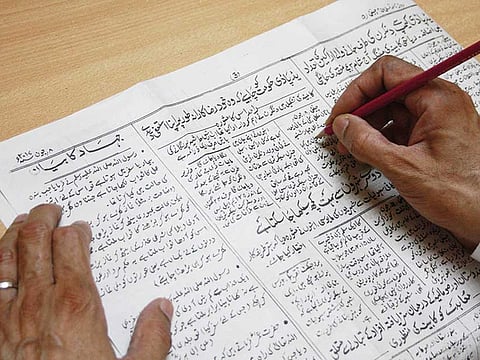Did you know hand-written newspaper existed?
The Musalman, an evening daily, has maintained its USP for more than three decades now

New Delhi: Syed Faizullah is taking one final look at the pages, just in case there’s an error. But that seems only a formality, as staff at The Musalman, an evening daily, leave no room for mistakes.
Faizullah, editor of The Musalman, tells Gulf News, “People working with us are so efficient that errors don’t happen. Some of them have been with the organisation for more than three decades.”
The Musalman is possibly the only Urdu handwritten newspaper in the world. Published from Chennai, the capital of the Indian state of Tamil Nadu, it has over 21,000 subscribers from Kashmir to Kanyakumari.
■ Despite a small set-up, staff at The Musalman are extremely loyal to the organisation.
The broadsheet consists of four pages. The front page for national and international news, the second and the third pages for local news and the fourth page for sports. There was a time when any late-breaking news meant scrapping the entire page and rewriting it. But for many years now, a panel on the front page is left blank in case there is some breaking news.
In the times of internet technology and 24-hours news channels, while even some prestigious international newspapers have folded, The Musalman has survived and kept its history alive for three generations. It was founded in 1927 by Syed Azmathullah and inaugurated by Dr Mukhtar Ahmad Ansari, then president of the Madras session of the Indian National Congress.
Located at 324 Triplicane High Road, after Azmathullah’s death, the newspaper was taken over by his son Syed Fazullah, who went on to edit it until his death in 2008.
Thereafter, Arifullah, the present editor, took over control and hopes the tradition will be maintained by the coming generations.
The newspaper functions from a 100 square-metre area, which houses the newsroom as well as printing press.
■ The newspaper’s masthead is cut out and stuck onto the paper each day.
It takes the katibs (practitioners of the ancient art of Urdu calligraphy) two hours to write from right to left, by hand, on ruled sheets measuring 38cm x 50cm.
“However, when printed, the lines do not show,” Arifullah explains.
The paper’s masthead is cut out and stuck onto the paper each day.
Thereafter, the pages are turned into a negative, followed by platemaking and then being mass-produced at the printing press. Finally, it is folded and each copy of The Musalman is sold on the streets of Chennai for 75 paisa (Dh0.04).
Clarifying the meagre cost, Arifullah says, “We believe in serving people of the nation. During my grandfather’s time the cost was 25 paisa. Over the time, it has increased only marginally.
“For me, it [the newspaper] means preservation of a dream and I am only taking the agenda forward, which I am very passionate about.”
Some may find it hard to believe, but despite a small set-up and primitive methods of functioning, staff at The Musalman are extremely loyal to the organisation.
“It is our love for the Urdu language that we are respected by people wherever we go. And working for the only handwritten newspaper in the world, makes one feel proud,” they say.
The editor adds, “We have correspondents across India, including in New Delhi, Mumbai and Kolkata. Since not all of them are well-versed in Urdu, they are free to submit computer-generated copies in English and Tamil. These are then translated into Urdu at the Chennai office.”
Does this mean computers are not required at any stage?
“People have often asked me to convert to computers, but I am not willing. Our readers are happy with this style and understand calligraphy easily. If we were to switch to computers in any way, there would be no difference between The Musalman and other newspapers,” Arifullah says.
Having dedicated his life to The Musalman, he says, “The USP of the newspaper is its calligraphy, which people are attracted to. And it is published in almost the same form since its inception.”
Undoubtedly, the newspaper has supporters who believe that handwritten Urdu is an art that needs to be encouraged, preserved and practised. But calligraphers lament the fact that the fine art of Urdu calligraphy is in danger of dying out in India because there’s little work for them.
In calligraphy, words are transformed into masterpieces. Until some decades ago, it was the defining feature of many Urdu dailies.
But the computer’s takeover and also the onslaught of computerised Urdu typesetting put an end to the job of calligraphers, who feel years of their training in the art has gone waste.
They often dissuade the younger generation from following the skill that was once patronised by the Mughals.
Sign up for the Daily Briefing
Get the latest news and updates straight to your inbox



